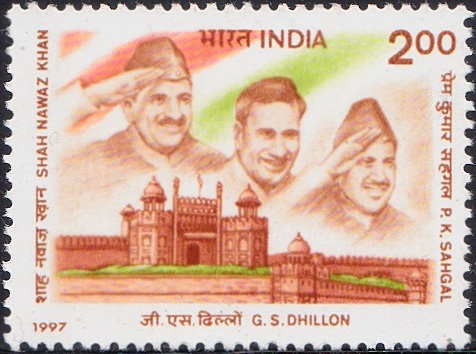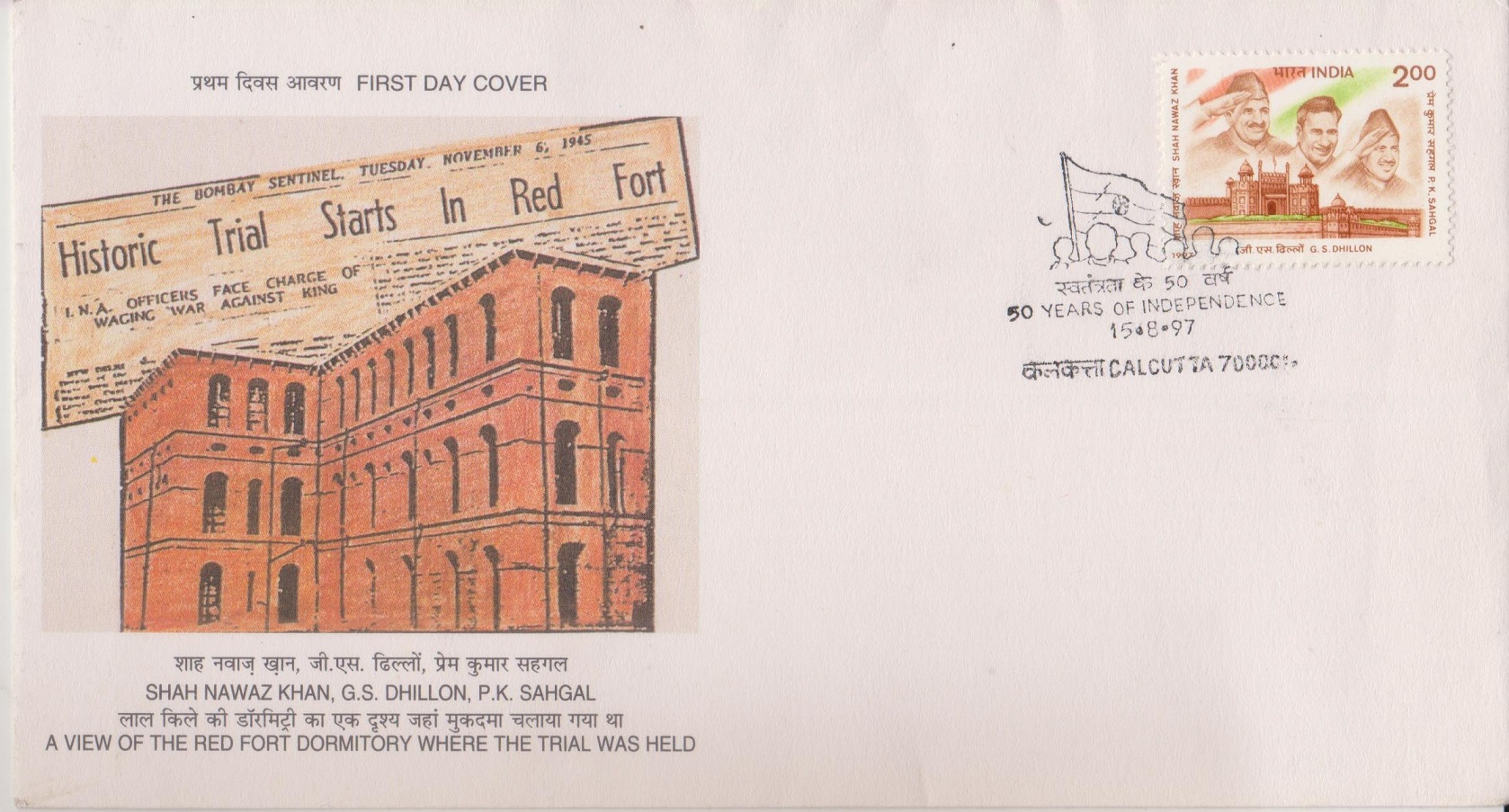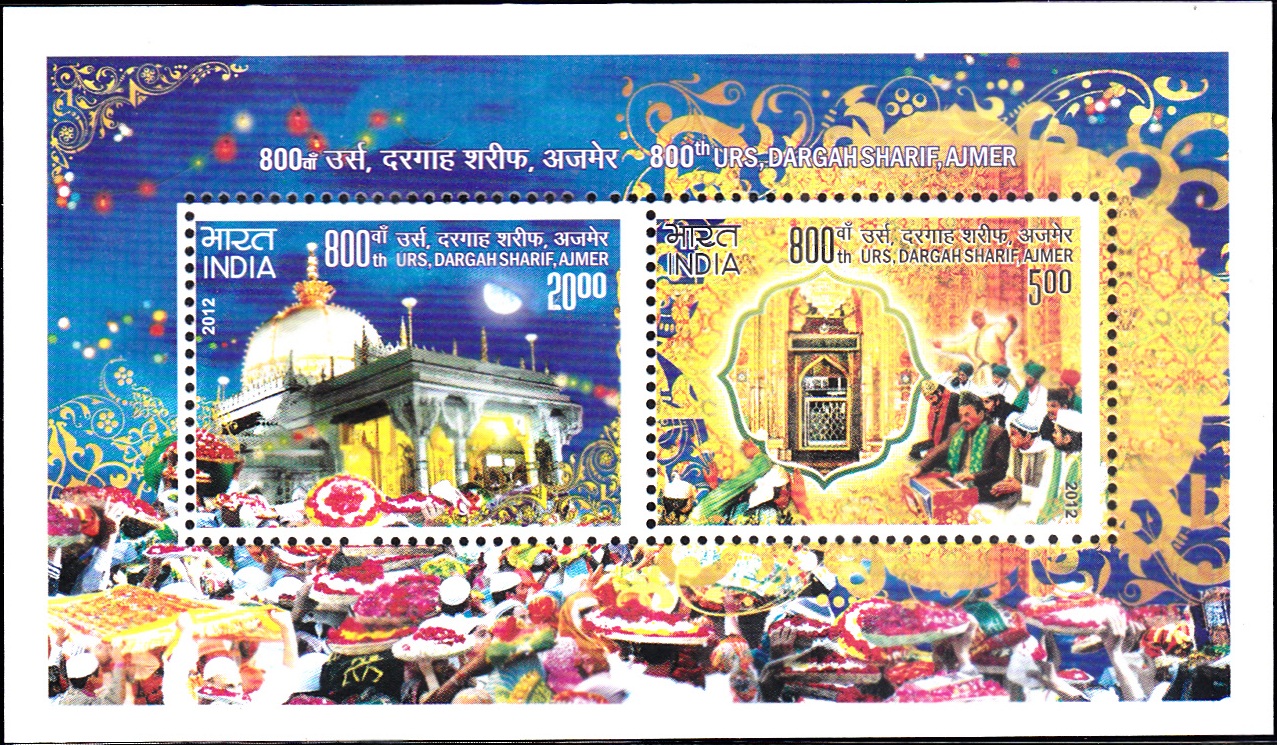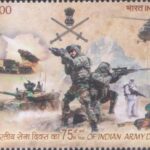
India’s Struggle for Freedom : Three INA Stalwarts
A commemorative postage stamp on the Indian National Army trials (INA trials), or the Red Fort trials of 3 INA Officers : Shah Nawaz Khan, P. K. Sahgal and G. S. Dhillon :

 Issued by India
Issued by India
Issued on Aug 15, 1997
Issued for : The Department of Posts is issuing this special postage stamp on the trial of three senior INA officers as a mark of the nation’s homage to the outstanding service rendered by three brave Indians and countless others who made the supreme sacrifice for the country’s independence.
Design : The stamp is an artist’s depiction of Shah Nawaz Khan, P. K. Sahgal and G. S. Dhillon against the battlements of the Red Fort. The first day cover shows a sketch of the Red Fort dormitory where the trial was held along with the news item appearing in “The Bombay Sentinel”, of November 6, 1945.
Credits :
Stamp design : S. Samanta
F.D.C. & Cancellation : Smt. Alka Sharma
Type : Stamp, Mint Condition
Colour : Multi Colour
Denomination : 200 Paise
Overall size : 3.91 x 2.90 cms.
Printing size : 3.55 x 2.54 cms.
Perforation : 13 x 13
Paper : Imported un w/m Adhesive Gravure Coated Stamp Paper in sheets size 50.8 x 53.5 cms.
Stamps Printed : 0.4 Million
Number per issue sheet : 35
Printing Process : Photogravure
Printer : India Security Press, Nasik
About :
- The end of the Second World War marked a dramatic change in the history of India’s struggle for freedom. From then onwards till the dawn of freedom in 1947, the political stage witnessed a wide spectrum of popular initiatives and perhaps the most significant, were the mass demonstrations of popular anger against the trials of INA personnel. After the final surrender by the INA to the British in South East Asia, the Government decided to try for sedition a large number of those who fought for the country’s freedom. The first trial began in 1945 at the historic Red Fort with three senior officers of the Azad Hind Fauz, Capt. Shah Nawaz Khan, Capt. P. K. Sahgal and Lt. G. S. Dhillon. They were charged with ‘waging war against His Majesty the King-Emperor….’. In reaction, people clashed with the police and many were killed. Workers went on a general political strike and normal life was paralysed. A strong team of lawyers including Bhulabhai Desai, Tej Bahadur Sapru and Jawaharlal Nehru defended the accused.
- Pt. Jawaharlal Nehru the country’s first Prime Minister commenting on this historic trial wrote in his foreword to “Two Historic Trials in Red Fort” edited by Moti Ram.
- “The legal issues were important enough….. But behind the law there was something deeper and more vital, something that stirred the sub-conscious depths of the Indian mind. Those three officers and the Indian National Army became symbols of India fighting for her independence……”
- Shah Nawaz Khan : He was born at Rawalpindi on January 24, 1914. After attending a course at the Indian Military Academy at Dehradun he was granted regular commission in the Indian Land Forces w.e.f. February 1, 1936. In February that year he was posted to the 14th Punjab Regiment. While posted at Singapore, Shah Nawaz Khan came under the influence of Netaji Subhas Chandra Bose and joined the Indian National Army. In September, 1943 Netaji decided to select a regiment to spearhead the advance into India. It was known as the Subhas Brigade and Shah Nawaz Khan was selected to command it. He expired on 9.12.1982.
- P. K. Sahgal : He was born at Hoshiarpur on January 25, 1917. He also attended a course at the Indian Military Academy, Dehradun and was granted regular commission in the Indian Land Forces from February 1st, 1939. He joined the I.N.A. in 1942 after a great deal of deliberations, “because I wanted freedom for my motherland and was ready to shed my blood for it”. He expired on 16.10.1992.
- G. S. Dhillon : He was born at Algon on April 4, 1915 and also attended the Indian Military Academy, Dehradun and was granted regular commission in the Indian Land Forces w.e.f. April 1940. After the surrender of Singapore on 15.2.1942 to the Japanese, he joined then I.N.A. then organised by Capt. Mohan Singh.
- When the general Court Martial commenced on November 5, 1945, photographers were excluded from the court room as soon as the accused officers were brought in. Reuters, Associated Press of America and several of the British and American press covered the trial. The three accused officers were informed of the remission in the sentence of transportation for life by the Commander-in-Chief on January 3rd, 1946 and they were released from Red Fort the same evening. The INA spirit began to spread in the armed forces and there were strikes by Signalmen and other sections of the Indian Army, Air Force personnel, the Royal Indian Navy and hundreds of thousands of non-industrial workers. This marked a significant turning point in the history of events to follow as the British could no longer rely upon the Indian sepoys to maintain their hold in India. Pt. Jawaharlal Nehru said in a speech in Bombay on 26th February 1946.
- “The INA episode and the recent Royal Indian Air Force and Royal Indian Navy strikes have rendered the country a very great service. The gulf that separated people from the armed forces has once for all been bridged. The people and the soldier have come very close to each other. They have now come to realise that they both have one common aim to free their country from the foreign yoke.”
- Text : Based on materials from :
1. India’s struggle for Independence NCERT
2. India’s struggle for Independence (1857-1947) : Bipan Chandra
3. Two Historic Trials in Red Fort edited by Moti Ram.








[…] The universal sympathy expressed all over India for the INA officers when they were tried for treason in the Red Fort Delhi gave a rude shock to Britishers, in as much as it clearly demonstrated that […]